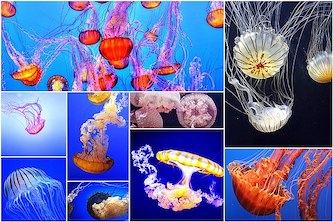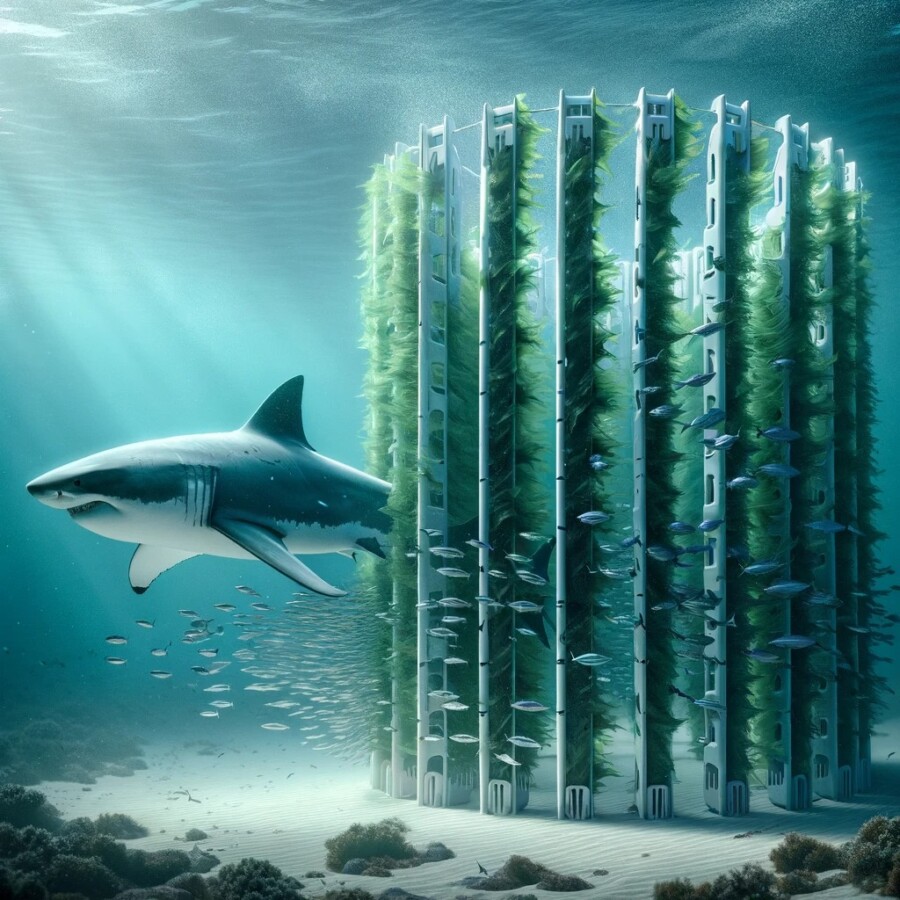There are more jellyfish in the sea and on the beaches in the UK than before. The sea is getting warmer because of the weather changing, and jellyfish like it. People saw a lot of big jellyfish and some special clear ones too. This might mean the sea is starting to feel like a warm place where these jellyfish come from. People used a computer or a phone to tell when they saw jellyfish, and they saw a lot near the west side of the UK.
People think there are more jellyfish because it was very hot in June. The world is getting warmer, and that changes the sea. The people who study the sea say we need to learn more about how the warm weather changes things for animals in the sea. They also saw more big sea turtles this year. There were 12 turtles seen, and four were the biggest kind.
Original news source: Boom in unusual jellyfish spotted in UK waters (BBC)
Listen
Slow
Normal
Fast
Group or Classroom Activities
Warm-up Activities:
– News Reporter Role-play
Instructions: Students pair up and take turns being a news reporter and an eyewitness. The reporter asks the eyewitness about their experience with the jellyfish sighting. The eyewitness uses phrases from the article to describe what they saw. Encourage beginners to use simple present tense and past tense verbs, such as “see,” “is,” “like,” and “come.”
– Opinion Poll
Instructions: Write a series of statements about the article on the board (e.g., “The sea is getting warmer,” “There are more jellyfish,” “We need to learn more about sea animals”). Students walk around the room and ask their classmates if they agree or disagree with each statement, practicing simple phrases such as “Do you think…?” and recording the number of agreements and disagreements.
– Vocabulary Pictionary
Instructions: Write down key vocabulary words from the article on slips of paper (e.g., “jellyfish,” “beaches,” “computer,” “turtles”). Divide the class into two teams. Players take turns drawing the words for their team to guess, without speaking or writing letters or numbers. Set a time limit for each turn. This helps students associate the words with images and reinforces their meaning.
– Sketch It
Instructions: Give students a copy of the article and ask them to draw scenes based on the text. For example, they might draw jellyfish in the sea, people using computers and phones, or the west side of the UK. After drawing, have them label each part of their sketch with vocabulary words from the article, which helps with word recognition and spelling.
– Future Predictions
Instructions: Have students write down predictions about what they think will happen with the jellyfish and the sea in the future, based on the article. For example, “There will be more jellyfish next year,” or “The sea will get even warmer.” Students can then share their predictions with the class, and the teacher can correct language errors and introduce future tense structures.
Comprehension Questions:
1. What is there more of in the sea and on beaches in the UK?
2. Why are there more jellyfish in the sea?
3. What kind of jellyfish did people see a lot of?
4. How did people tell others when they saw jellyfish?
5. Where did people see a lot of jellyfish in the UK?
6. Why do people think there are more jellyfish now?
7. What other big animal did people see more of this year in the sea?
Go to answers ⇩
Listen and Fill in the Gaps:
There are more (1)______ in the sea and on the beaches in the UK than before. The sea is (2)______ warmer because of the weather changing, and jellyfish like it. People saw a lot of big jellyfish and some special clear ones too. This might mean the sea is starting to feel like a warm place where these jellyfish come from. People used a (3)______ or a phone to (4)______ when they saw jellyfish, and they saw a lot near the (5)______ side of the UK.
People think there are more jellyfish because it was very hot in June. The world is getting (6)______, and that changes the sea. The people who study the sea say we need to learn more about how the warm (7)______ changes things for animals in the sea. They also saw more big sea turtles this year. There were 12 turtles (8)______, and four were the biggest kind.
Go to answers ⇩
Discussion Questions:
Students can ask a partner these questions, or discuss them as a group.
1. What is a jellyfish?
2. Do you like jellyfish? Why or why not?
3. How would you feel if you saw a jellyfish on the beach?
4. What is the sea?
5. Do you think it’s good when the sea gets warmer? Why or why not?
6. Have you ever seen a jellyfish? Where?
7. What is a computer? Do you use one?
8. What is a phone? Do you have one?
9. Do you like hot weather? Why or why not?
10. What is a turtle? Do you think turtles are cute?
11. Have you ever seen a big animal? What was it?
12. Do you think we should learn about sea animals? Why or why not?
Individual Activities
Vocabulary Meanings:
Match each word to its meaning.
Words:
1. jellyfish
2. sea
3. warm
4. computer
5. phone
6. turtles
7. beaches
8. UK
Meanings:
(a) Animals that live in the sea and have a hard shell
(b) A big area of salty water
(c) Not cold
(d) A creature that lives in the water and has a clear body and stinging tentacles
(e) The sandy or rocky edge of the water
(f) A country in Europe where London is
(g) A thing you use to call or send messages
(h) A machine that can do math and play games
Go to answers ⇩
Multiple Choice Questions:
1. Why are there more jellyfish in the sea and on the beaches in the UK?
(a) The sea is getting colder
(b) The sea is getting smaller
(c) The sea is getting cleaner
(d) The sea is getting warmer
2. What do jellyfish like?
(a) Cold water
(b) Dirty water
(c) Warm water
(d) Salty water
3. How did people report seeing jellyfish?
(a) Sending a letter
(b) Using a computer or a phone
(c) Telling a friend
(d) Yelling loudly
4. Where did people see a lot of jellyfish?
(a) Near the east side of the UK
(b) Near the west side of the UK
(c) Near the north side of the UK
(d) Near the south side of the UK
5. Why do people think there are more jellyfish?
(a) It was very cold in June
(b) It was very rainy in June
(c) It was very windy in June
(d) It was very hot in June
6. What else did people see more of in the sea this year?
(a) Big sea turtles
(b) Small sea turtles
(c) Dolphins
(d) Sharks
7. How many big sea turtles were seen this year?
(a) 12
(b) 5
(c) 20
(d) 8
8. Where were most of the big sea turtles seen?
(a) Near the east side of the UK
(b) Near the north side of the UK
(c) Near the west side of the UK
(d) Near the south side of the UK
Go to answers ⇩
True or False Questions:
1. There are fewer jellyfish in the sea and on the beaches in the UK than before.
2. People didn’t see many big jellyfish and some ordinary unclear ones too.
3. They also saw more big sea turtles this year.
4. People used a computer or a phone to tell when they saw jellyfish, and they saw a lot near the west side of the UK.
5. The world is not getting warmer, and that doesn’t affect the sea.
6. The sea is getting warmer because of the weather changing, and jellyfish like it.
7. People don’t think there are more jellyfish because it was very cold in June.
8. The people who study the sea say we need to learn more about how the warm weather changes things for animals in the sea.
Go to answers ⇩
Write a Summary:
Write a summary of this news article in two sentences.
Check your writing now with the best free AI for English writing!
Writing Questions:
Answer the following questions. Write as much as you can for each answer.
Check your answers with our free English writing assistant!
1. Why are there more jellyfish in the sea near the UK?
2. What kind of weather do jellyfish like?
3. How do people tell others when they see jellyfish?
4. Where did people see a lot of jellyfish?
5. What other big sea animals did people see more of this year?
Answers
Comprehension Question Answers:
1. What is there more of in the sea and on beaches in the UK?
There are more jellyfish in the sea and on beaches.
2. Why are there more jellyfish in the sea?
The sea is getting warmer and jellyfish like warm water.
3. What kind of jellyfish did people see a lot of?
People saw a lot of big jellyfish and some special clear ones.
4. How did people tell others when they saw jellyfish?
People used a computer or a phone to tell others when they saw jellyfish.
5. Where did people see a lot of jellyfish in the UK?
People saw a lot of jellyfish near the west side of the UK.
6. Why do people think there are more jellyfish now?
People think there are more jellyfish because it was very hot in June.
7. What other big animal did people see more of this year in the sea?
People saw more big sea turtles this year.
Go back to questions ⇧
Listen and Fill in the Gaps Answers:
(1) jellyfish
(2) getting
(3) computer
(4) tell
(5) west
(6) warmer
(7) weather
(8) seen
Go back to questions ⇧
Vocabulary Meanings Answers:
1. jellyfish
Answer: (d) A creature that lives in the water and has a clear body and stinging tentacles
2. sea
Answer: (b) A big area of salty water
3. warm
Answer: (c) Not cold
4. computer
Answer: (h) A machine that can do math and play games
5. phone
Answer: (g) A thing you use to call or send messages
6. turtles
Answer: (a) Animals that live in the sea and have a hard shell
7. beaches
Answer: (e) The sandy or rocky edge of the water
8. UK
Answer: (f) A country in Europe where London is
Go back to questions ⇧
Multiple Choice Answers:
1. Why are there more jellyfish in the sea and on the beaches in the UK?
Answer: (d) The sea is getting warmer
2. What do jellyfish like?
Answer: (c) Warm water
3. How did people report seeing jellyfish?
Answer: (b) Using a computer or a phone
4. Where did people see a lot of jellyfish?
Answer: (b) Near the west side of the UK
5. Why do people think there are more jellyfish?
Answer: (d) It was very hot in June
6. What else did people see more of in the sea this year?
Answer: (a) Big sea turtles
7. How many big sea turtles were seen this year?
Answer: (a) 12
8. Where were most of the big sea turtles seen?
Answer: (c) Near the west side of the UK
Go back to questions ⇧
True or False Answers:
1. There are fewer jellyfish in the sea and on the beaches in the UK than before. (Answer: False)
2. People didn’t see many big jellyfish and some ordinary unclear ones too. (Answer: False)
3. They also saw more big sea turtles this year. (Answer: True)
4. People used a computer or a phone to tell when they saw jellyfish, and they saw a lot near the west side of the UK. (Answer: True)
5. The world is not getting warmer, and that doesn’t affect the sea. (Answer: False)
6. The sea is getting warmer because of the weather changing, and jellyfish like it. (Answer: True)
7. People don’t think there are more jellyfish because it was very cold in June. (Answer: False)
8. The people who study the sea say we need to learn more about how the warm weather changes things for animals in the sea. (Answer: True)
Go back to questions ⇧














